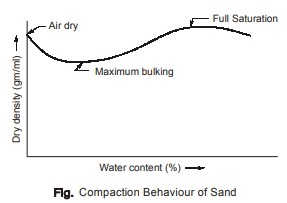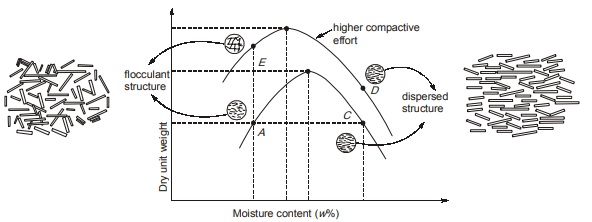Compaction Behaviour of Sand
The moisture-dry density relationship, as obtained from a laboratory test on a cohesionless sand is shown in figure below:
- Initially there is decrease in dry unit weight with the increase in water content. This is due to bulking/behaviour of sand i.e. capillary tension in pore water prevents soil particles coming closer. The maximum bulking occurs at 4 – 5% water content.
- The maximum dry unit weight occurs when soil is either completely saturated or dry.
- When water content is increased further, there is fall in dry unit weight again.

EFFECT OF COMPACTION ON PROPERTIES OF SOILS
Soil Structure
- The water content at which the soils is compacted plays an important role in the engineering properties of the soils.
- At low water content, attractive forces between the particles are stronger than repulsive forces. Hence, soils compacted at a water content less than the optimum water content generally have a flocculated structure.
- Increasing the water content, increases the repulsive forces. Hence, soils compacted at water content more than the optimum water content usually have a dispersed structure.
- If the compactive effort is increased there is a corresponding increase in the orientation of the particles and higher dry densities are obtained, as shown by the upper curve.

Permeability
- The permeability of a soil depends upon the size of voids. Due to increase in water content for a given compactive effort there is an improved orientation of the particles and a corresponding reduction in the size of voids which cause a decrease in permeability.
- For a given compactive effort, the permeability decreases sharply with increase in water content on the dry side of optimum. The minimum permeability occurs at or slightly above the OMC. Beyond OMC, the permeability may show a slight increase, but always remain much smaller than on the dry side of optimum.
- If the compactive effort is increased, the permeability of the soil decrease due to increased dry density and better orientation of particle.
Compressibility
- At relatively low stress levels, a soil compacted wet side (dispersed soil) of optimum is more compressible than the soil compacted dry side (flocculated soil) of optimum. Therefore, for construction of embankment, the soil is compacted on the dry side of optimum.
- At high stress levels, the compressibility increases due to breakdown of the structure, now the flocculated structures with larger void volume, can undergo a large volume decrease.
Swelling
- A soil on the dry side of optimum has a higher water deficiency and a more random particle arrangement. It can therefore, imbibe more water than a soil on the wet of optimum, therefore more swelling occur on dry side of optimum.
Shrinkage
- Soils compacted on the wet of optimum, have nearly parallel orientation of particles which allows the particles to pack more efficiently as compared to the randomly oriented particles on the dry side of optimum.
- Therefore, soils compacted on the wet of optimum tend to exhibit more shrinkage upon drying than those compacted on the dry of optimum.
Shear Strength
- The shear strength of the compacted soils depends upon the soil type, the moulded water content, drainage conditions, the method of compaction etc.
- In general, at a given water content, the shear strength of the soil increases with an increase in the compactive effort till a critical degree of saturation is reached. With further increase in the compactive effort, the shear strength decreases.

